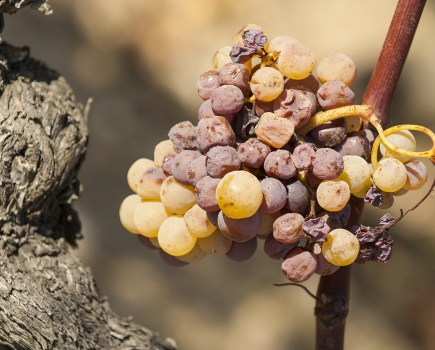Effective weed management in the undervine area is key to maximising crop productivity, and can also help reduce frost risk in emerging buds, as Hutchinsons agronomists Rob Saunders and
Chris Cooper explain.
The next month is a crucial period for frost risk in vines as fresh, young growth is highly susceptible to freezing overnight temperatures.
There are a host of options for reducing the impact of late frosts, and this includes the management of ground beneath vines.
Research has shown a clear reduction in temperature when long vegetation is left underneath vines, which may be due to cold air becoming trapped, and there being less radiative heat than on bare soil. Indeed, uncultivated bare ground has also been shown to be better at re-radiating the day’s heat than a cultivated surface.
While there are a host of non-chemical weed control options available (see below), targeted herbicide application remains the most straightforward tool for managing undervine weeds at this time of year.
Options are pretty limited though, especially given restrictions on application timings. The Roundup Powermax formulation of glyphosate (containing 720 g/kg of active ingredient) is the principal contact herbicide fully approved for use in table and wine grapes.
On particularly weedy sites, especially those with harder to control species such as thistles, docks and nettles, consider cutting back large weeds before applying glyphosate to ensure product is taken up by fresh growth. Adding wetters and using appropriate water volumes will improve efficacy, and for best results, treat weeds before they become too large. Creeping thistle for example, becomes much harder to control with herbicides once it grows beyond rosette stage.
Some weeds, like nettle, will be better controlled if Roundup is mixed with the desiccant Shark (carfentrazone-ethyl), although remember to observe the golden ratio of these active ingredients to achieve maximum uptake by the weeds. Also be aware that Shark carries a 90-day harvest interval.
Products based on pelargonic acid or fluazifop-P-butyl offer other options, but the former has restrictions on when it can be applied and the latter only controls a limited range of grass weeds. The propyzamide-based herbicide Kerb can only be applied between October and the end of January, so we are now well beyond the final use date.
Non-chemical options
While herbicides offer the simplest control of weeds underneath vines, it is useful to consider what alternatives might work for individual sites, soil types and weed spectrums.
There are inevitable questions to be asked over the speed of non-chemical operations, their cost and sustainability though, especially given the ever-present pressure to reduce carbon emissions.
Below are some options to consider:
- Biodegradable membranes: Useful when establishing new vineyards, although some pernicious weeds may still require manual weeding
- PAS-100 certified compost or woodchips: Can suppress weeds, although the availability and cost of transporting and applying material can be an issue. The nutrient content of compost may benefit young vines, but NVZ regulations can limit application timing and quantity, depending on nutrient content. For woodchips, beware nitrogen can get tied up by soil biology breaking down woody material, leaving less available to vines. Generally it is better to apply thinner layers of wood chip more frequently. Woodchip can also spread Armillaria mellea (Boot-lace fungus)
- Mechanical cultivation: Can be very effective at taking out roots of dicotyledonous weeds, but is better suited to established vineyards (4 years+) due to the risk of damaging vines. Best done regularly in dry conditions as wet cultivations smear soil and regrowth is more likely. Disturbing the soil surface also increases erosion risk and may affect soil biology
- Flame weeders: Can be slow and require specialist technology that may be heavy and prone to technical issues. There are also question marks over the sustainability of fuels used
- Water weeders: Different systems are available using either high pressure water jets or steam. Operational speed, effectiveness and disturbance of soil surface are potential issues
- Electric weeders: An idea first tried in the 1950s, can be effective on fleshy weeds with tap roots (e.g. thistle or dock), but less so on grasses. Safe around vines due to the woody stems, although systems require large amounts of power, especially if attempting to treat a wide swathe. Given its effectiveness in treating creeping thistle, it is frustrating that no electric kit is commercially available.
Boost frost protection
Frost protection can be further enhanced with the use of glycine-betaine based products, such as Lalstim Osmo. The natural extract is an osmoprotectant that increases the strength of plant tissue and boosts the circulation of sap flow, water and nutrients, thereby improving tolerance to freezing. It should ideally be applied 24-48 hours before frost is due, offering some extra protection against light frost (down to -2°C). Beyond this, only heated fruiting wires, solid set irrigation or frost candles can protect vines against more severe temperature drops.



